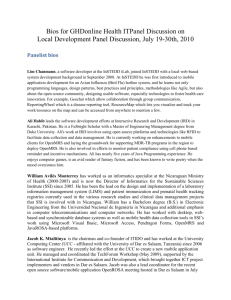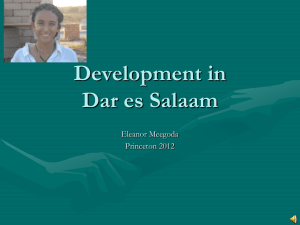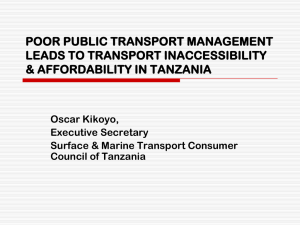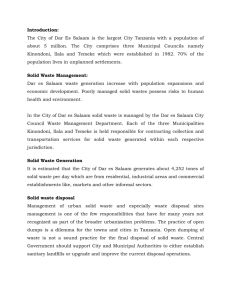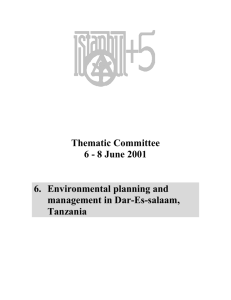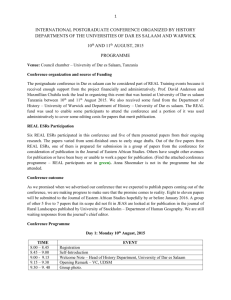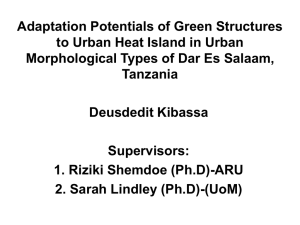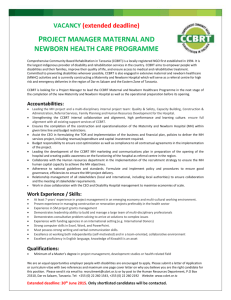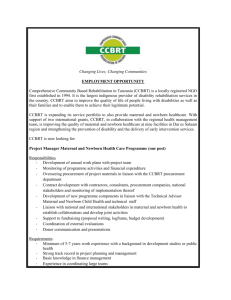institutionalizing urban agriculture in dar es salaam city through the
advertisement
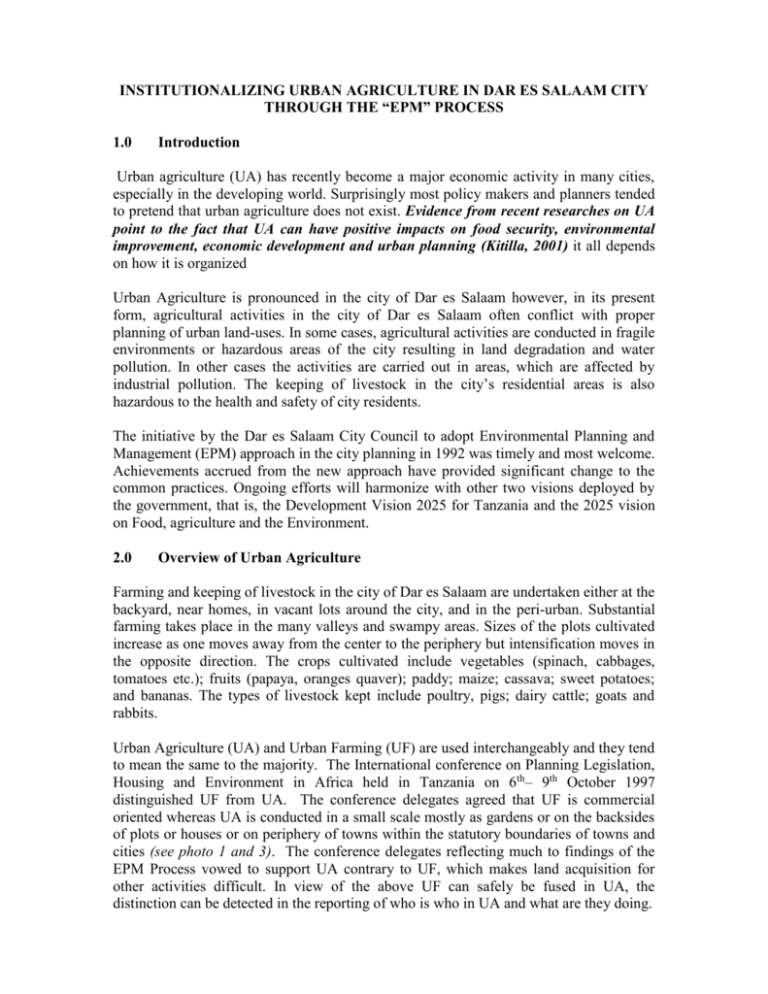
INSTITUTIONALIZING URBAN AGRICULTURE IN DAR ES SALAAM CITY THROUGH THE “EPM” PROCESS 1.0 Introduction Urban agriculture (UA) has recently become a major economic activity in many cities, especially in the developing world. Surprisingly most policy makers and planners tended to pretend that urban agriculture does not exist. Evidence from recent researches on UA point to the fact that UA can have positive impacts on food security, environmental improvement, economic development and urban planning (Kitilla, 2001) it all depends on how it is organized Urban Agriculture is pronounced in the city of Dar es Salaam however, in its present form, agricultural activities in the city of Dar es Salaam often conflict with proper planning of urban land-uses. In some cases, agricultural activities are conducted in fragile environments or hazardous areas of the city resulting in land degradation and water pollution. In other cases the activities are carried out in areas, which are affected by industrial pollution. The keeping of livestock in the city’s residential areas is also hazardous to the health and safety of city residents. The initiative by the Dar es Salaam City Council to adopt Environmental Planning and Management (EPM) approach in the city planning in 1992 was timely and most welcome. Achievements accrued from the new approach have provided significant change to the common practices. Ongoing efforts will harmonize with other two visions deployed by the government, that is, the Development Vision 2025 for Tanzania and the 2025 vision on Food, agriculture and the Environment. 2.0 Overview of Urban Agriculture Farming and keeping of livestock in the city of Dar es Salaam are undertaken either at the backyard, near homes, in vacant lots around the city, and in the peri-urban. Substantial farming takes place in the many valleys and swampy areas. Sizes of the plots cultivated increase as one moves away from the center to the periphery but intensification moves in the opposite direction. The crops cultivated include vegetables (spinach, cabbages, tomatoes etc.); fruits (papaya, oranges quaver); paddy; maize; cassava; sweet potatoes; and bananas. The types of livestock kept include poultry, pigs; dairy cattle; goats and rabbits. Urban Agriculture (UA) and Urban Farming (UF) are used interchangeably and they tend to mean the same to the majority. The International conference on Planning Legislation, Housing and Environment in Africa held in Tanzania on 6th– 9th October 1997 distinguished UF from UA. The conference delegates agreed that UF is commercial oriented whereas UA is conducted in a small scale mostly as gardens or on the backsides of plots or houses or on periphery of towns within the statutory boundaries of towns and cities (see photo 1 and 3). The conference delegates reflecting much to findings of the EPM Process vowed to support UA contrary to UF, which makes land acquisition for other activities difficult. In view of the above UF can safely be fused in UA, the distinction can be detected in the reporting of who is who in UA and what are they doing. Urban agriculture has many definitions; in the Tanzanian context Urban Agriculture (UA) is commonly referred to the carrying out of farming activities in the built-up areas where open spaces are available as well as keeping livestock in the built-up areas and in the peri-urban (UA Working Group). Reasons for practicing UA agriculture are different within income groups. The low income earners who constitute the majority of the urban population practice as a means of providing subsidy or extra income whereas the high income take it as a hobby and to a certain extent as a preparation for urban farming at a latter stage, preparing for retirement. In the past ten years Urban Agriculture received very limited recognition from the Authorities although it was remarkable as shown in Map 1 Annexed and Table 1 below. TABLE 1: APPLICATION FOR FARMS AS APPROVED BY DAR ES SALAAM CITY COUNCIL: URBAN PLANNING COMMITTEE UP TO 1991 DISTRICT Kinondoni Ilala Temeke TOTAL NO. OF APPLICANTS 469 96 64 629 AREA (ACRES) 1269 256 201 1,726 Source: Ministry of Lands and Human Settlements Development Of late professionals and politicians have realized that if UA is taken seriously and properly organized can serve as one of the effective land management tool/measure. Reflecting to the conference on Planning Legislation observations UA in the City of Dar es Salaam is being undertaken at a greater scale especially in peri-urban areas and calls for immediate actions to alleviate the likelihood of negative impacts. It is on the basis of the aforementioned premises and in support of the Local Agenda 21 and the Habitat Agenda, the city authorities vowed to organize UA using the participatory approach, the EPM process in order to ensure sustainable human development. 3.0 Adoption of the EPM Process in Tanzania: for whose interest? The city of Dar es Salaam like many urban areas in Tanzania is characterized by urban sprawl and growth patterns, which are costly in infrastructure and service provision. The problems constraining smooth operation of urban development activities in Tanzania have been mainly contributed by the urban planning concept used. Urban planning had been aiming at reaching an ideal way of life. Planners dreamt to be able to realize the city they have in mind through Master Plans which have for a long time been basically instruments dealing with the physical dimensions intended for the desired city. In actual fact the government of Tanzania shouldering much of the responsibility of implementing the prepared Master Plans, faced acute shortage of resources to provide social infrastructure and services necessary for urban development. Planners had been preparing urban development plans without taking into account the real needs and aspirations of the communities in the particular areas. In this regard, urban planning became an impediment in urban development; the cultural, social and economic processes, which constitute the dynamics of production of the urban society, were often ignored. When planners ignored the reality, a deep gap emerged between the ideal city and the real city. The city of Dar es Salaam portrays all the features of such deficiency. More than 70% of the city population lives in un-authorized settlements, at the margins of rules and legislations. Examples of such settlements are Manzese, Hanna nasif and Tandika. In the 1990s the city of Dar es Salaam had reached a striking stage of rapid population growth coupled with dwindling resources. Appropriate planning and management of the city was more important at this stage when the city was experiencing rapid growth which in a situation of severe economic limitations strained the existing socio-economic infrastructure resulting in shortage of housing, social services, public utilities and increasing unemployment and poverty. A change from the traditional planning approach and acceptance of the Community being the main agency through which the human settlements would be created and improved necessitated a change from the traditional planning approaches to EPM approach. This paper considers city residents as capable entities in developing their own priorities in all sectors, discussing affordable technical solutions, mobilizing local resources as well as arranging for implementation with special reference to UA. Experience from the Sustainable Dar es Salaam Project (SDP) activities carried out by all stakeholders in the city have demonstrated that when people become a subject of their own development rather than mere objects or beneficiaries, they can design solutions based on ideas emanating from the community It was also anticipated through the EPM process lessons can be drawn to ensure more appropriate policy directions for the future, strengthening the local capacity of the partners to jointly plan, co-ordinate, manage environmental and development activities; and henceforth Preparing a long-term strategic and integrated investment and urban development plan through policy formulation and policy implementation. The EPM approach advocating dialogue or participatory moved the city planning approach from the idealist ideas and illusions of traditional urban planning to participatory planning for the benefit of all those concerned. 4.0 The Context of EPM Process in relation to UA: What we did and How How we did: Steps taken In 1992 the city of Dar es Salaam adopted the Environmental Planning and Management (EPM) Approach in the City Consultation. The City Consultative meeting identified 9 key environmental issues, they are: Improving solid waste management Upgrading un-serviced settlements Servicing city expansion Managing surface waters and liquid waste Air quality management and urban transportation Managing open spaces, recreational areas, hazard lands, green belts and urban agricultural potential Managing the economy and integrating petty trading Co-coordinating city centre renewal Managing coastal resources The city consultation was followed by mini- consultations, issue specific consultative meetings. In 1993 the city held a mini-consultation to deliberate on UA, which was among the priority issues. In the mini- consultation stakeholders agreed that UA in the city contribute almost 30%of household food supplies and it has become an integral part of livelihood strategies of many people. Following the mini-consultation the city formed a working group, which worked out strategies to put UA in a city agenda. The working group applied the following EPM steps: Clarifying issues to be addressed; Involving those whose cooperation is required; Setting priorities; Negotiating management strategies; Agreeing on environmental action plans; Initiating and implementing demonstration projects in collaboration with respective institutions; Monitoring and evaluating progress and making periodic adjustments and Provided input to the Strategic Urban Development Plan. Who was involved and why? The working group formed were multi- disciplinary. Various segments of the urban dwellers (the urban poor, men, youth groups and women groups) were involved. They include: Village governments (especially in the peri-urban areas) Various government ministries: The Ministry of Agriculture and Cooperatives, Ministry of Lands and Human Settlements Development, Ministry of Natural resources, Tourism and Environment, Ministry of Water, Energy and Minerals; The Dar es Salaam City Council/ Dar es Salaam City Commission, Popular sector groups, NGOs and CBOs within the city and in the urban villages. National Urban Water Authority, Ministry of Agriculture & Cooperative Development Urban farmers in view of their action regarding legislations, land tenure issues, availability and non-availability of land for UA etc. Representation of the above stakeholders was fair and the size of the group depended on the issue being addressed. The Dar es Salaam City Council was the coordinating institution and custodian of laws and by-laws guiding operations in an urban context. Other members provided information and ideas from respective locality. In view of that conflicts of interest were minimum as there were hardly a collision in ideas. This is because ideas presented were not personal but represented a certain section of the city population and through EPM process members knew failure to address interests of a section of city residents is detrimental. In case of differences they were managed through a participatory approach under the guidance of the responsible coordinator. For smooth operation the role of the coordinator was merely to coordinate efforts of the multisectoral stakeholders, he/she had to be neutral. The results of the process from action plan preparation, implementation of demo projects and integration of UA and peri-urban in the city urban zonification was good. One of the successful demo projects in UA is the Mbutu Agricultural project. Findings of the working group which included results of the demo projects were a basis of deciding where and to what extent UA can be practiced in the city as reflected in the Strategic Urban Development Plan (SUDP) see Map 2 annexed. In the SUDP special land zones have been designated for UA. Ideas necessary for revising municipal by-laws and regulations were also worked out and a platform for coordination of UA established and enhanced. The process from inception of UA problems, developing solutions, implementing and incorporating in SUDP took about five years (1993-1998). Not much has been done in-terms of new initiatives from 1998 to-date but ideas developed by the working group are being disseminated and tried in other urban centers adopting the EPM process. The Urban Vegetable Promotion Project is coordinating UA however; there are ongoing initiatives/efforts to define who should be the facilitator. Success Factors A number of forces have driven the mushrooming of urban farming and livestock keeping in Dar es Salaam. Among the forces forcing city residents engage themselves into farming is Poverty. Poverty in Tanzania is predominantly a rural phenomenon. People from the rural areas have migrated in urban areas in hope of earning a better living. Next to poverty is decreasing formal employment: Formal employment is decreasing many people turn to the informal sector to do what they are used to, i.e. farming. Since as much as 90% of a poor family's income can go toward food, urban farming helps thousands of people escape from extreme poverty. So urban farming creates easy jobs and food. Other forces include: Proximity to markets Availability of services: extension, (piped) water, inputs etc. Government policy, e.g. making Saturday a non-working day so that employees should tend activities to supplement incomes. Culture: some people keep livestock essentially because that is their culture. Non-enforcement of1aws, regulations and by-laws, everybody does according to wishes. Problems experienced In spite of the Policies, Legislations, By-laws and Technical Instruction guiding UA, some of them are not certain on their provisions. Uncertain provisions tend to inhibit smooth operation and in a way complicate efforts to achieve intended goals. Government Notice (G.N) No. 10 of 5th February 1993 can be cited as a good example of uncertain provisions. The notice states that: No person shall occupy more than three acres of Urban Land for farming. No person shall, except where that person practice zero grazing keeps animals in an urban area. Moreover any farming activity which may be deemed to constitute a nuisance in the form of noise or smell or pose physical danger to the safety of public shall not be permitted in areas other than those zoned for urban farming. This notice is complimented by the Dar es Salaam City (Animal in City Area) By-law 1989 which provide that animals will be kept in the city area after obtaining a permit from the City Director and the maximum number should be 4 cattle kept at zero grazing. Contrary to the above provisions there are significant number of surveyed farms exceeding three acres in the city of Dar es Salaam as reflected in Table 2 below. TABLE 2: NUMBER OF SURVEYED FARMS IN DAR ES SALAAM NAME OF DISTRICT NO. OF SURVEYED FARMS TOTAL ACARAGE (in Ha) AVERAGE FARM SIZE (in Ha) 1,081 7,640.5 6.89 ILALA 114 671.2 5.89 TEMEKE 55 2,848.1 51.78 1,250 11,169.8 8.9 KINONDONI TOTAL Source: Ministry of Lands and Human Settlements Development It is interesting to note that the Ministry has realized the shortcomings in this provision, revisions have been made and they will be published soon. How participatory the new provisions leave much to be desired but it is anticipated working group observations have been accommodated. With regard to number of cattle kept in the city, a good number of cattle also graze out of their sheds especially in peri-urban areas and cattle are also tolerated in prime areas of the city as reflected in Table 3 below. Uncertainty causes nonenforcement. TABLE 3: DISTRIBUTION OF ANIMALS AND CHICKEN IN CENTRAL AREA WARDS WARD Gerezani Upanga East Upanga West Kivukoni Mchafukoge TOTAL CATTLE 23 95 32 61 - Source: Ilala Municipality, 2000 GOATS 33 13 24 - PIGS 16 - CHICKEN 200 5900 1150 510 - Policy changes and Institutionalization: What were the main results? UA recorded very successful results the underlying factor to the success are public awareness and stakeholder/community involvement in developing interventions. The major achievements realized during 1993 to 1998 are the implemented demonstration projects from which UA has received substantial recognition and attention. Of late both the politicians and professionals (especially planners) have realized that UA is an environmental management tool in developing sustainable modern cities. City residents are free in their operations as depicted in photo 7. Recognition of UA is reflected in several laws and regulations in actual support like provision of extension services and learning sites and seedlings. Photo 6 shows one of the City Horticultural gardens revived under the UA programme in the city. Among the Policies are: the Local Government Act (Section 80) of 1982, the Town and Planning Ordinance (Cap 378, Urban Farming Regulations of 1992), the National Land Policy of 1995, Section 6.7.0, the Agricultural and Livestock Policy (1997), and the National Human Settlements Development Policy (Jan 2000). These are some of the policies supporting development of UA but the list is not exhaustive there are others in the form of Government Notices and some in Technical Instructions. Policies are presented in general statements as shown below, implementation are complimented with By-laws of the respective urban authority. Example 1. The Agricultural and Livestock Policy (1997) The Policy observes that agriculture is not a principle function of towns but when properly organized UA has the potential to provide employment, income and is a supplementary source of food supply and The policy states that "the government will continue to regulate the conduct of UA and will ensure that it does not disrupt planned urban development” Example 2. The National Human Settlements Development Policy (Jan 2000) states clearly how UA can be dealt with in an urban context: The Policy provide that the Government Shall: i. designate Special areas within planning areas whereby people will be granted legal rights to engage themselves in agricultural activities; ii. continue to regulate and research on the conduct of UA and will ensure that it does not disrupt planned urban development; iii. review existing laws to facilitate planned UA; iv. facilitate the construction of appropriate infrastructure to mitigate/ prevent land degradation, water pollution and health and safety hazards in areas whereby agriculture is permitted. Encouraged by the achievements of the SDP in building environmental planning and management capacities and processes, the Government of Tanzania was requested by the municipalities and agreed to replicate the experience in the nine municipalities (i.e. Arusha; Dodoma; Iringa; Mbeya; Morogoro; Moshi; Mwanza; Tabora and Tanga); and hence the National Programme for Promoting Environmentally Sustainable Urban Development was launched in July, 1997. It is worth pointing out that ‘the objectives and strategies of SCP-National level remained more less the same as those of SDP, despite the fact that SCP is now considered as a ‘programme’. Lessons Learned The process of institutionalizing UA from the consultative meetings to implementing demo projects was long and tiresome. Many lessons have been learnt in the process, below is a summary of what had been learnt throughout the process. Communities are capable entities in developing their own priorities, working out solutions and arranging for implementation. A strategy that relates project support to the priorities developed by the communities themselves stands a better chance to succeed. The driving force behind community initiatives is the problems experienced and the willingness to find solutions All was possible through enhanced cooperation between different stakeholders in planning and implementation. This idea is very much incorporated in the new concept of Environmental Planning and Management that was adopted in the city in 1992 and is being replicated in all major urban centres in Tanzania. Potential Problems and Risks (Challenges) Besides the achievements highlighted above, there are a number of potential problems and risks related to the urge to practice UA by many city residents and calls for immediate attention. They include: The city of Dar es Salaam and other Urban Centers have no prior plans to guide urban development while residents are eager to continue practicing UA. People are investing in the so-called farm plots. A visit in peri-urban parts in Kinondoni Municipality reveals a different story; one might think Dar es Salaam is at the suurbanization stage. Residents mainly from middle-income bracket have acquired large pieces of land and developed them for residential and agriculture. The existing development poses a serious problem to land availability in future. Watering of the farms using treated water add pressure to the water company to provide treated water, which has to be shared with ordinary housekeeping activities. Most hazard lands are discharge points of both industries and households, food stuffs produced in these areas mostly make use of the polluted waters create a great health risk to consumers. Efforts to use some of the solid waste in manure is too small, UA as it is practiced now adds a headache to waste management. In view of that it increases the urban crisis, the ongoing process to prepare compost manure is promising. Increases air and noise pollution and to a lesser extent complicate efforts to eliminate mosquitoes, number one killer next to AIDS. Careful planning can eliminate these risks, below are some of the recommendations to minimize the risks. However, monitoring and evaluation are essential elements in this process to establish the missing links. 5.0 Conclusion and Recommendations Dar es Salaam City has demonstrated that UA can be effectively integrated in Urban Planning (Land Use) and is now recognized as one of the major land uses and an important informal opportunity/ activity. This was made possible through the EPM process, which applied the broad-based, multi-actor, bottom-up and participatory approach. The EPM process aimed at enabling ordinary people to take charge of their lives and to make communities more responsible for their development contrary to the Idealistic Master Planning approach. The ultimate goal was all Stakeholders in the city (individuals and communities) understanding the process and projects and being able to follow with or without external assistance. Reflecting to the EPM process and the output, the following are recommended. These recommendations are based on the findings of the EPM process in Dar es Salaam and other deliberations like the International conference on Planning Legislation, Housing and Environment in Africa held in Tanzania on 6th– 9th October 1997 which discussed the EPM findings objectively. They are applicable to all urban areas in the Tanzania context. In order to promote Urban Agriculture expertise from various relevant sectors should be sought in order to reduce the prospects of health hazards and pollution. Environmental Impact Assessment Studies (EIAS) should be conducted to minimize negative impacts especially environmental pollution Planning standards, Development Control, (Order and Planning) Legislations should be drafted in a manner that promotes and facilitates urban agriculture. Studies through pilot and demonstration projects should be undertaken to provide data on urban agriculture for informed decision making. Facilitation of UA should also address issues of access to markets. Photo 5 shows how useful bicycles can be, with increasing transport cost and declining incomes UA development plans should include facilitation of low cost mobility means of transport. To achieve the above the following institutional aspects need to be in place to facilitate the process. This is possible through the physical planning process incorporating EPM techniques. Urban agriculture should be part and parcel of the urban fabric for it to be sustainable. UA should be planned to avoid negative repercussions in terms of pollution. Establishment of a regulatory machinery to deter unplanned development in the form of unapproved land use changes resulting from the appreciation of land values. Local Authorities should act as overseers, there should be capacity building in Local Authorities to enable them carry out development control. There should be public participation in formulation of urban agricultural policies, which includes - Communities, NGOs, families, Local Authorities and professionals. Intensive consultation amongst all stake holders and research is needed to be able to determine: "How many people are “involved in urban agriculture, what are the economic benefits, what is the demand for urban agriculture, and suitability of land/soil” Continuous education by local authorities to local communities should be a continuous flow, two-way system of information i.e. from community to local authorities/professionals and vice versa on: The environmental impact of their agricultura1activity i.e. smell, flies destruction of crops by animals, religious beliefs in relation to certain agricultural activities, irrigation of crops: using treated Water. Provision of technical advice and sensitization of the public or local community in order to fill the value of urban agriculture. Need for political will and get to change the attitude and behavior of the general public (Citizens). TABLE 4: SUMMARY OF PROBLEMS AND STRATEGIES FOR URBAN AGRICULTURE WHAT IS THERE? WHAT IS THE PROBLEM? STRATEGIES By-laws are there Non enforcement of laws Awareness raising Instruments for enforcement Non implementation of UA Participatory approaches in exist Plans are there need implementation see Map 3 Enforcement accepted approach (EPM) is there plans Lack of awareness to other stakeholders By-laws review is not participatory reviewing By-laws Enforcement through communities Create incentive to enforce By-laws In Tanzania time for dialogue is gone, we have Policies, Legislations, Government Notices and Technical Instructions in place. We only need to organize ourselves find the right “Drive/ Facilitator” and move forward. References: 1. Government Notices, Orders, Technical Instructions and Circulars Commonly Referred To in Pursuance of Human Settlements Development – Compiled by Human Settlements Division, Ministry of Lands and Human Settlements Development 2. Vegetable Production on Open Spaces in Dar es Salaam – Spatial Changes from 1992 to 1999 –By: Stefan Dongus, Albert Lewis University of Freiburg/Germany Institute of Physical Geography Section of Applied Physiogeography in Tropics and Sub-tropics (APT0 with assistance of Ibraham Nyika, Ministry of Agriculture & Cooperatives, Tanzania. 3. Proposition Paper Managing Urban Agriculture in Dar es Salaam – by Camilus L. Sawio, Department of Geography, University of Dar es Salaam in Collaboration with SDP Urban Agriculture Working Group. 4. Managing Open Spaces, Recreational Areas, Hazard Lands and Urban Agriculture – Compiled by Working Group Members on Managing Open Spaces, Recreational Areas, Hazard Lands and Urban Agriculture. 5. Integrated Rural Dar es Salaam Development Vision (1998-2008) – Technical Proposal – by Economic and Social Research Foundation (ESRF) –Preliminary Draft 6. Institutional Aspects of Urban Agriculture in the City of Dar es Salaam, Tanzania: By Michael Mwalukasa, October, 1999. 7. Urban Farming Conditions in Tanzania: Final Report- Ministry of lands and Human Settlements Development. 8. Fourth International Conference on Planning Legislation, Housing and Environment in Africa: Dar es Salaam, Tanzania 6th – 9th October 1997
